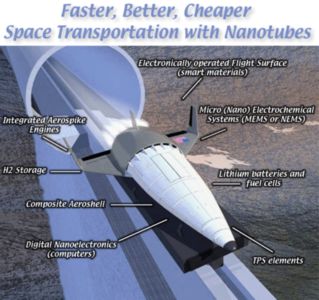Nanotechnology in Space
Nanotechnology may hold the key to making space flight more practical. Advancements in nanomaterials make lightweight solar sails and a cable for the space elevator possible. By significantly reducing the amount of rocket fuel required, these advances could lower the cost of reaching orbit and traveling in space. In addition, new materials combined with nanosensors and nanorobots could improve the performance of spaceships, spacesuits, and the equipment used to explore planets and moons, making nanotechnology an important part of the ‘final frontier.’
Space Flight and Nanotechnology: Applications under Development
Researchers are looking into the following applications of nanotechnology in space flight:
-
Employing materials made from carbon nanotubes to reduce the weight of spaceships like the one shown below while retaining or even increasing the structural strength.
-
Using carbon nanotubes to make the cable needed for the space elevator, a system which could significantly reduce the cost of sending material into orbit. Nova has a nice video explaining the concepts.
-
Including layers of bio-nano robots in spacesuits. The outer layer of bio-nano robots would respond to damages to the spacesuit, for example to seal up punctures. An inner layer of bio-nano robots could respond if the astronaut was in trouble, for example by providing drugs in a medical emergency. For more about this see page 30 of this report on Bio-Nano-Machines for Space Applications.
-
Deploying a network of nanosensors to search large areas of planets such as Mars for traces of water or other chemicals. To read more about this, see page 27 of this report on Bio-Nano-Machines for Space Applications.
-
Producing thrusters for spacecraft that use MEMS devices to accelerate nanoparticles. This should reduce the weight and complexity of thruster systems used for interplanetary missions. One cost-saving feature of these type of thrusters is their ability to draw on more or less of the MEMS devices depending upon the size and thrust requirement of the spacecraft, rather than designing and building different engines for different size spacecraft.
-
Using carbon nanotubes to build lightweight solar sails that use the pressure of light from the sun reflecting on the mirror-like solar cell to propel a spacecraft. This solves the problem of having to lift enough fuel into orbit to power spacecraft during interplanetary missions.
-
Working with nanosensors to monitor the levels of trace chemicals in spacecraft to monitor the performance of life support systems.
 Photo
courtesy of NASA
Photo
courtesy of NASA
Spaceflight and Nanotechnology: Research Organizations
The Center for Nanotechnology at NASA Ames is looking at how nanotechnology can be used to reduce the mass, volume, and power consumption of a wide range of spacecraft systems including sensors, communications, navigation, and propulsion systems.
The Johnson Space Center Nano Materials Project is working on nanotube composites with the aim of reducing spacecraft weight.
The LiftPort Group is dedicated to making the space elevator reality. Their target date is October, 2031.
The Space Nanotechnology Laboratory at MIT is developing high performance instrumentation for use on spaceflights.
Spaceflight and Nanotechnology: Reference Material
NASA Institute for Advanced Concepts report: Ultra-Thin Solar Sails for Interstellar Travel.
Nanoforum report: Nanotechnology in Aerospace
NASA Institute for Advanced Concepts report: The Space Elevator.
Related Pages